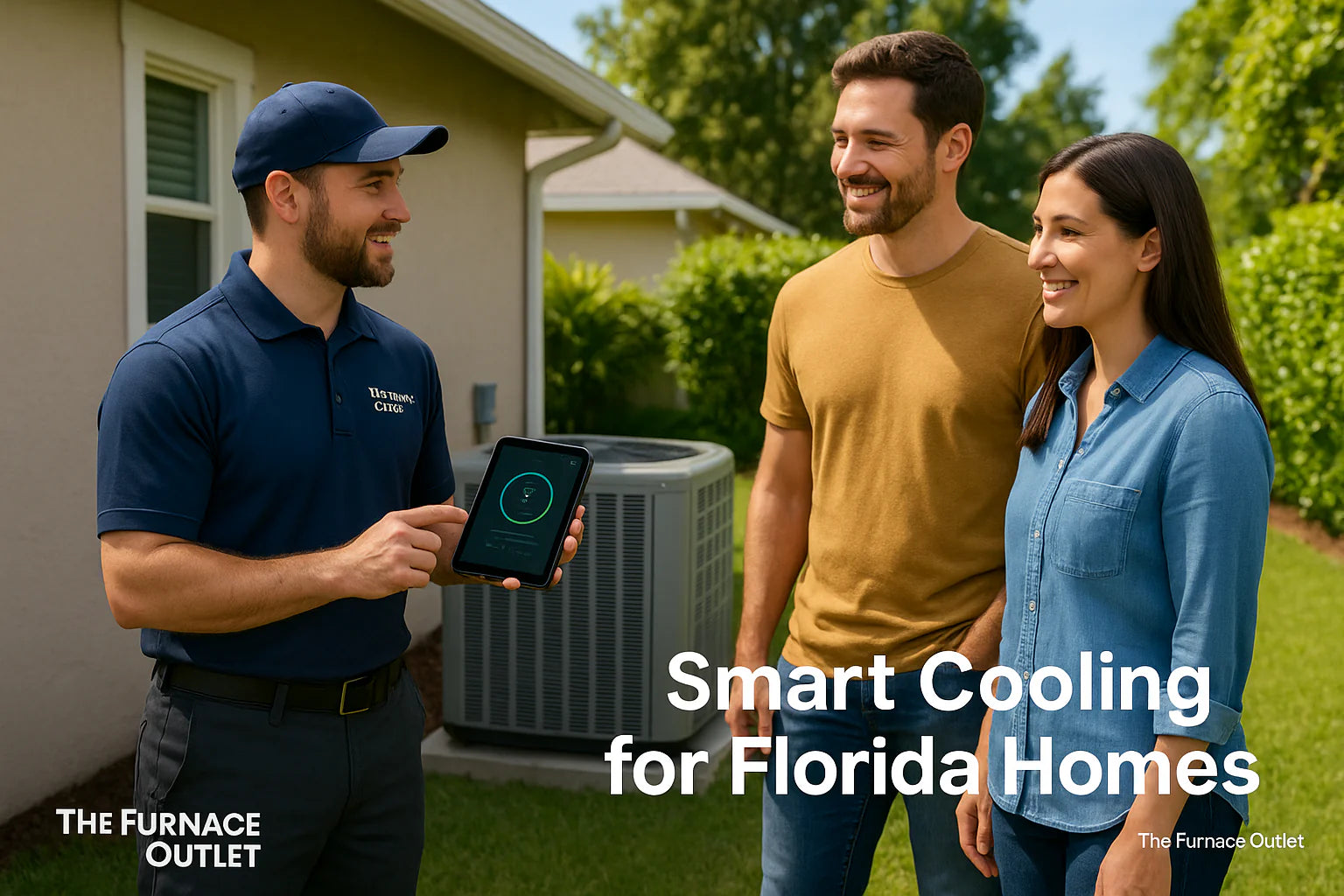Why Zone 1A Is a Different Animal
Florida isn’t just hot; it’s soaking wet. Summer dew points often sit above 70 °F, meaning every degree of cooling must also pull pints of water from the air. Standard “cold air only” units run short cycles and leave rooms clammy. The fix is an HVAC system engineered to cool and dehumidify in long, gentle runs. Think variable-speed compressors and indoor coils sized for moisture removal. Skip those and you’ll fight mold, swollen wood floors, and sweaty window glass all year.
SEER2 Rules: The New Efficiency Line in the Sand
Since 2023, the DOE has set the Southeast minimum at 14.3 SEER2 (≈ 15 SEER) for equipment under 45 k BTU. Larger units need 13.8 SEER2 or better. Meeting but preferably beating those numbers slashes kilowatts in a climate where ACs can run 3,000+ hours per year. When shopping, look for yellow EnergyGuide labels or browse high-SEER2 R32 condensers. Your power bill will thank you. (SEER2.com)
Humidity Control Features That Work
Moisture is the comfort killer. Prioritize:
-
Enhanced dehumidification modes that slow the blower for longer coil contact time.
-
Dual-stage or inverter compressors that idle at 30–50 % capacity to keep drying air without over-cooling.
-
Demand-controlled ventilation to limit outdoor moisture intake.
Brands like Trane, Carrier, and Lennox bundle these tricks into premium models. Pair them with a smart air handler so airflow stays dialed in.
Central AC vs. Heat Pump vs. Mini-Split
|
System |
Best-Fit Scenario |
Pro Tip |
|
Central AC |
Bigger homes, existing ducts |
Add a matching R-32 coil for peak SEER2. Shop coils |
|
Inverter Heat Pump |
Year-round comfort, modest heating loads |
Go ENERGY STAR to hit 15 SEER2+ with strong dehumidification mode. |
|
Ductless Mini-Split |
Room additions, zoned remodels |
DIY kits save install cash, see mini-split bundles. |
How Variable-Speed Compressors Save Money
Old single-stage units blast 100 % output, shut off, then repeat, terrible for humidity and your meter. A variable-speed compressor ramps anywhere from 30 % to 100 %, sipping power while wringing moisture. Expect up to 30 % lower bills and super-steady temps. It’s like cruise control for your AC.
Fighting Salt-Air Corrosion
Coastal air is a metal-eating cocktail of moisture and salt. Look for:
- Epoxy-coated condenser fins
- Stainless-steel fasteners
- Factory-applied anti-corrosion spray
Mount the outdoor unit on a raised, non-metallic pad and rinse coils with fresh water every quarter. Need a ready-for-salt package? Check corrosion-resistant packaged units.
Smart Thermostats: Tiny Brain, Big Savings
A Wi-Fi thermostat learns run times, adapts to humidity, and lets you tweak temps from the beach. Pair it with a unit that supports humidity set-points, aim for 45–55 % RH. Many OEMs bundle free apps; just be sure your installer wires the extra dehumidify terminal.
Don’t Oversize Manual J Matters
Bigger isn’t cooler. In Zone 1A, an oversized system drops the temperature too fast, then shuts off before pulling enough moisture. Have a pro run a Manual J load that factors wall insulation, duct leakage, and window orientation. Size to sensible heat and latent load—usually 20 BTU per square foot for well-insulated homes.
Installation Must-Dos for Flood-Prone Lots
-
Elevate the condenser 12–18 inches above grade on a hurricane-rated stand.
-
Slope the slab so rainwater drains away.
-
Use PVC-coated line sets and seal wall penetrations with silicone to keep salty air out. Installers on the Gulf swear by adding a sacrificial zinc anode near coil connections as cheap insurance.
Maintenance Checklist: Six-Month Rhythm
-
Replace filters (MERV 8–11) every 30–60 days in summer.
-
Hose off outdoor coil fins quarterly.
-
Check the condensate line for algae; flush with vinegar.
-
Inspect the blower wheel and the indoor coil for dust build-up.
-
Tighten electrical lugs; salt creep loosens connections.
-
Schedule a pro tune-up each spring—book through the Design Center if you need help finding a tech.
Comfort Boosters Worth Considering
Even the best AC can struggle on 95 °F/90 % RH days. Add-ons that move the needle:
-
Whole-home dehumidifier tied into the return plenum.
-
UV lights to curb mold in damp air handlers.
-
Surge protector—Florida storms zap boards.
Find accessories and surge kits in the HVAC accessories aisle.
FAQ
Q: Is a heat pump efficient in Florida’s heat?
Yes. Modern inverter heat pumps still hit 15 SEER2+ and deliver cheap winter warmth when temps dip into the 50s—no gas line needed.
Q: How often should I change filters in a humid climate?
Check monthly; swap when they look gray. High humidity causes dust to form faster.
Q: Do I need a separate dehumidifier if my AC is sized right?
Usually not, but if indoor RH stays above 60 % overnight, a small whole-home dehumidifier can finish the job.
Q: What’s the warranty on corrosion-resistant models?
Most brands offer 10-year compressor and parts coverage; some add a 5-year coastal corrosion warranty. Read the fine print or call our Help Center.
Q: Where can I get sizing help?
Upload your floor plan to our free Design Center, and an estimator will run the Manual J for you.







